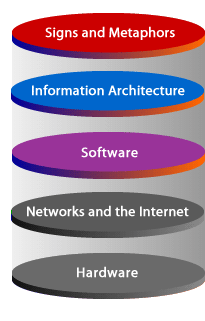Software and Web Interaction Model

| Signs and Metaphors | Signs are visual markings or sounds that present information. Metaphors cue users about the functionality of the site through the use of icons or images. Together, Signs and Metaphors create the look and feel of the site. |
| Information Architecture | Information Architecture organizes Signs and Metaphors into a cohesive structure. In addition, it lays down the path for navigating through the site. |
| Software | Software comprises underlying components (applications) that enable the display of Signs and Metaphors. In addition, software creates, stores, and manages all resources available over the Web. |
Interaction Models and the Key to Creating Flow
An interaction model is the outline for how a product operates, taking into account user behavior and experience. Have you ever struggled with an updated app or referred to the documentation for a new operating system?
You need to plunge into the application straight away. That is the reason great plan is dependably imperceptible, permitting you to jump into the application without perusing pages of documentation. It banks on your previous encounters and assumptions by displaying everything for your satisfaction. In the best stages, those cooperations are in amazing sync with your perspective and work pair with the framework. You, as a client, are in a stream state and not all worried about how the framework functions.
You need to plunge into the application straight away. That is the reason great plan is dependably imperceptible, permitting you to jump into the application without perusing pages of documentation. It banks on your previous encounters and assumptions by displaying everything for your satisfaction. In the best stages, those cooperations are in amazing sync with your perspective and work pair with the framework. You, as a client, are in a stream state and not all worried about how the framework functions.